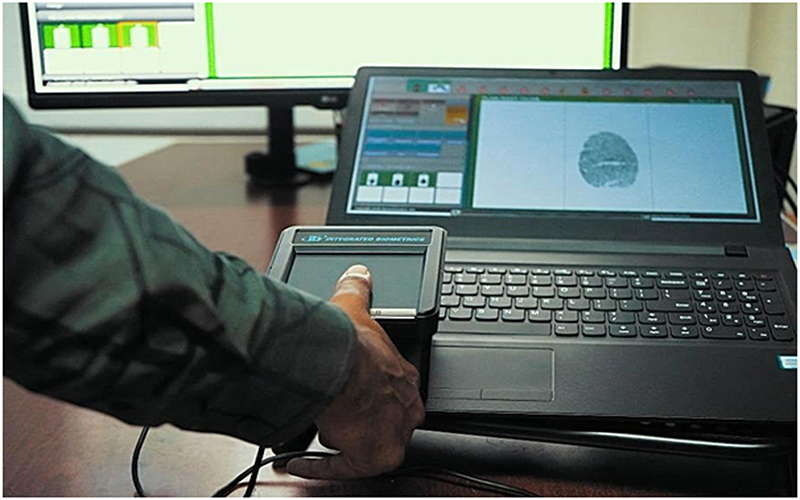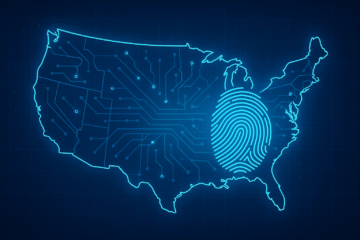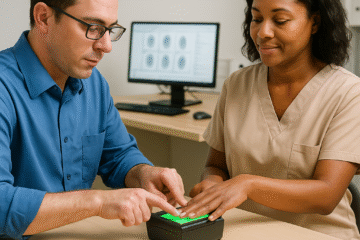Key Facts
- Live Scan fingerprinting is a digital process that offers faster, cleaner, and more reliable results compared to traditional ink fingerprinting.
- It provides higher accuracy and clarity, reducing the risk of smudging and distortion, leading to quicker approvals.
- Live Scan significantly reduces processing time and errors, ensuring real-time quality checks before submission.
- This method is eco-friendly, eliminating the need for ink and paper, thus reducing environmental waste.
- Live Scan is widely accepted by agencies nationwide and internationally, making it the preferred choice for identity verification.
Fingerprinting has long been a trusted method for identity verification, background checks, and law enforcement purposes. Traditionally, ink fingerprinting was the standard, but with advancements in technology, Live Scan digital fingerprinting has become the preferred method. Understanding the key differences between these two fingerprinting techniques can help individuals and organizations make informed decisions when choosing a fingerprinting service.
What is Traditional Ink Fingerprinting?
Traditional fingerprinting involves rolling each finger onto an ink pad and pressing it onto a fingerprint card. This method has been used for decades by law enforcement agencies and businesses requiring fingerprint records. However, ink fingerprinting has several drawbacks, including smudging, inconsistencies, and the need for physical storage and mailing.
What is Live Scan Fingerprinting?
Live Scan fingerprinting is a digital process that captures fingerprints electronically without using ink. This method provides faster, cleaner, and more reliable results. The fingerprints are transmitted directly to law enforcement databases, eliminating the need for paper fingerprint cards and manual processing.
1. Higher Accuracy and Clarity
Live Scan technology produces high-resolution digital fingerprints, reducing the risk of smudging and distortion common with ink fingerprinting. The enhanced clarity helps law enforcement and background check agencies analyze prints more effectively, leading to quicker approvals and fewer rejections.
2. Faster Processing Time
Traditional ink fingerprinting requires manual submission and processing, which can take weeks. In contrast, Live Scan transmits fingerprints electronically, significantly speeding up background checks. Many government agencies prefer digital submissions for their efficiency and reliability.
3. Reduced Errors and Rejections
Ink fingerprinting often results in unclear or incomplete prints, leading to rejected applications. Live Scan eliminates this issue by providing real-time image quality checks, ensuring that prints meet required standards before submission. This reduces delays and additional costs for redoing fingerprinting.
4. Convenience and Cleanliness
Live Scan is a touchless, mess-free process, unlike ink fingerprinting, which can be messy and require additional cleanup. Digital fingerprinting also removes the need for physical storage, reducing paper waste and improving document management.
5. Enhanced Security
Digital fingerprinting ensures secure transmission of biometric data, reducing the risk of tampering, loss, or theft. Live Scan encrypts fingerprint data and sends it directly to authorized agencies, enhancing confidentiality and protection against identity fraud.
6. Compliance with Modern Requirements
Many state and federal agencies now mandate or prefer Live Scan submissions due to its accuracy and efficiency. Employers, licensing agencies, and law enforcement departments increasingly require Live Scan for background checks, making it the preferred choice for those needing fingerprinting services.
7. Immediate Confirmation of Print Quality
Live Scan systems instantly analyze fingerprints for quality, allowing adjustments before final submission. This real-time verification helps ensure that all prints meet agency requirements, reducing processing delays and rejections.
8. Better Suitability for High-Volume Applications
Organizations that require frequent fingerprinting, such as schools, healthcare institutions, and security firms, benefit from Live Scan’s speed and accuracy. Unlike ink fingerprinting, which requires manual handling and drying time, Live Scan allows for seamless, large-scale processing.
9. Eco-Friendly Alternative
Ink fingerprinting involves paper forms, ink pads, and physical storage, contributing to environmental waste. Live Scan eliminates the need for ink and paper, making it an eco-friendly option that aligns with modern digital practices.
10. Accepted Nationwide and Internationally
Many agencies and institutions prefer or require Live Scan fingerprinting over ink-based methods. Its digital format ensures wider acceptance across state and federal agencies, law enforcement, and global organizations that rely on biometric identification.
Conclusion
When comparing Live Scan vs. traditional ink fingerprinting, digital fingerprinting is the clear winner in terms of accuracy, speed, security, and efficiency. With faster processing, fewer errors, and greater compliance with modern regulations, Live Scan has become the gold standard for identity verification and background checks.
At Anshin Mobile Notary & Livescan, we provide professional Live Scan Fingerprinting, FBI Background Checks, Fingerprint Cards, Notary Public, Apostille, Business Services, and Expungemen services to meet your needs. Contact us today to schedule your fingerprinting appointment and experience the benefits of Live Scan technology.
Frequently Asked Questions
Is Live Scan fingerprinting better than traditional ink fingerprinting?
Yes, Live Scan is faster, more accurate, and preferred by many agencies due to its digital submission process, reducing the chances of errors and rejections.
How long does it take to process Live Scan fingerprints?
Live Scan fingerprints are transmitted electronically, and results are typically processed within 24-72 hours, depending on the agency.
Do all agencies accept Live Scan fingerprints?
Most government and law enforcement agencies accept Live Scan, but some may still require ink fingerprints for specific purposes. Always check with the requesting agency.
Can Live Scan be used for FBI background checks?
Yes, Live Scan is commonly used for FBI background checks, providing quick and accurate results for employment, licensing, and security clearances.
How much does Live Scan fingerprinting cost?
Live Scan fees vary based on the agency, type of screening, and state regulations. Additional fees may apply for background check processing.
By choosing Live Scan fingerprinting, individuals and businesses can ensure efficient, secure, and high-quality fingerprint submissions for various legal and professional purposes.
Also Read: Notarized Affidavits: What They Are and When You Need One | Best Guide 2025





0 Comments